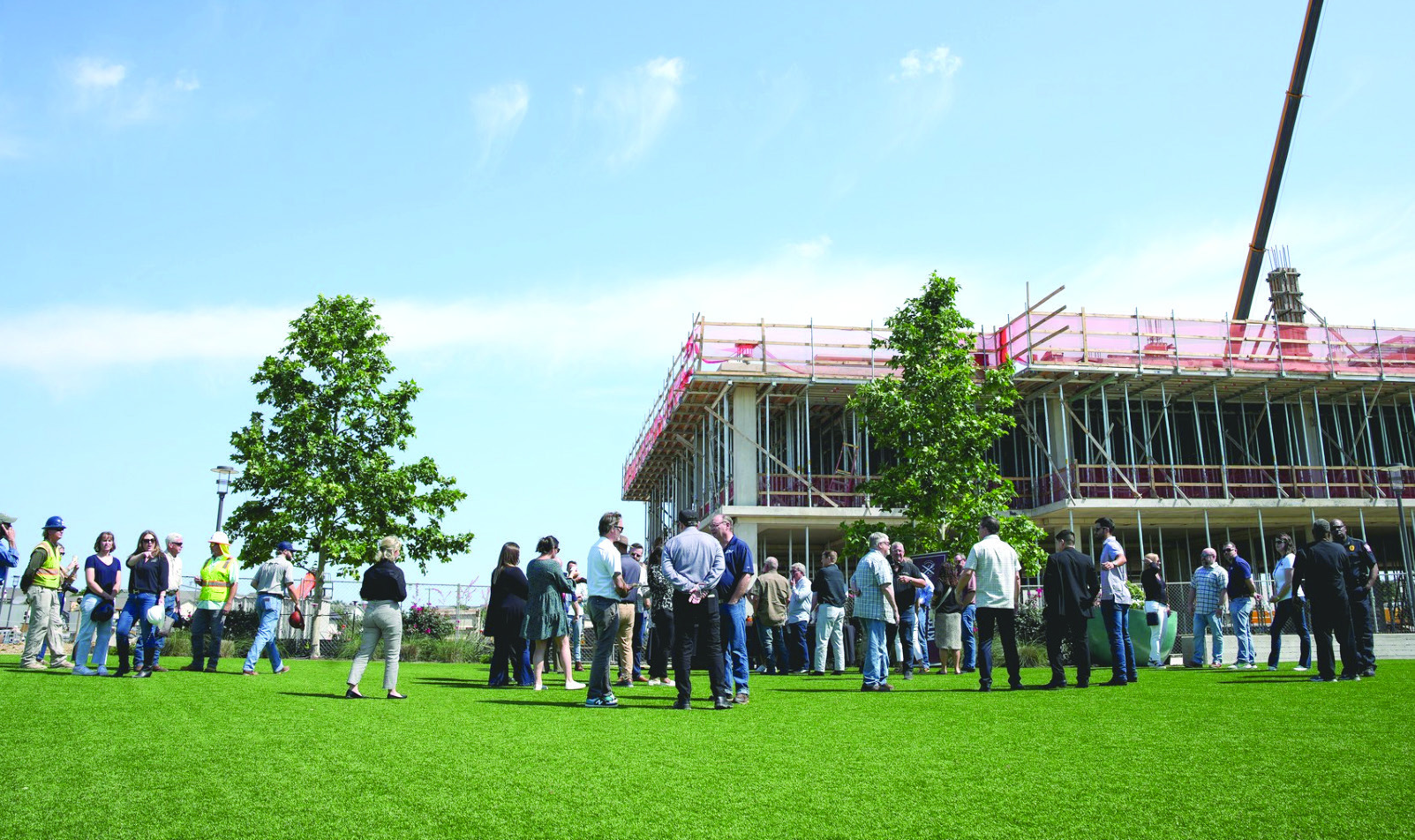A burgeoning modern-day gold rush is underway in the rich prairie land between Taylor and Hutto, sparked by the arrival of Samsung Austin Semiconductor’s cuttingedge chipmaking facility.
What transpires for Taylor and Hutto will mark a significant chapter in the annals of technological innovation, regional development and geopolitical prominence, drawing both inspiration and caution from the storied rise of Silicon Valley.
Samsung’s $44 billion high-tech behemoth inside Taylor’s city limits promises not only thousands of jobs and economic prosperity, but also heralds a potential shift in the region’s identity.
Like Charles Dickens’ “A Tale of Two Cities,” Hutto and Taylor stand at the brink of a new era, where decisions on growth, infrastructure and community will shape not just their own destinies but set a precedent for future tech hubs.
THENEWTECHNOLOGY
Samsung Austin Semiconductor’s stateof- the-art facility in Taylor is set to produce the next generation of semiconductor microchips using the advanced 2-nanometer process node. These chips are not only smaller and 45% faster, but also reduce energy consumption by 75%.
This advancement promises to revolutionize various industries, according to analysts.
Samsung has been in fierce competition with Taiwan Semiconductor Manufacturing Co. and Intel to bring these chips to market. Currently, Samsung is leading the race, having secured the first contract for 2-nanometer node AI chip production with the Japanese startup Preferred Networks Inc.
Under the Creating Helpful Incentives to Produce Semiconductors — or CHIPS — and Science Act, the U.S. government has allocated $6.4 billion to Samsung for constructing a new fabrication plant in Taylor. This facility is slated to start producing the advanced chips by 2026.
The aim of the CHIPS Act is to strengthen America’s technology supply chain and compete against China.
The establishment of Samsung’s facility is already having a significantly impact on Taylor, attracting new businesses and reshaping the local economy, officials said.
Developments such as a new data center in Hutto and a technology park along U.S. 79 highlight this trend.
IMPACT ON TAYLOR
The presence of this advanced technology hub is poised to transform Taylor’s local economy and community from a quiet town into a bustling center of technological advancement, city leaders said.
In addition, the creation of nearly 2,000 jobs is expected to attract a diverse and skilled workforce to the area, driving demand for housing, schools and services, they add.
Taylor native and businessman Jesse Ancira Jr., a former mayor and Taylor Independent School District board president, noted that while Samsung’s presence has generated economic impact, substantial population growth has not yet occurred.
“People are investing in Taylor, but actual residency hasn’t caught up yet; school enrollment is down, indicating an imbalance,” said Ancira, who also served as chief of staff for former Texas House Speaker Joe Straus, R-San Antonio.
City records show that since Samsung announced its presence in 2021, about 856 new residents have moved to Taylor yearto- date, based on an average household size of 2.51 people. The number of newcomers peaked at 227 in 2022 but has since decreased to 61 in 2023 and 53 so far in 2024.
Ancira attributes some of the stagnant growth to property owners raising prices in response to the project.
He also points to challenges associated with the Envision Taylor Comprehensive Growth Plan, which existed before Samsung’s announcement and has hindered some residents in the city’s extraterritorial jurisdiction from selling their properties to developers due to zoning regulations.
“People are still navigating these issues, and developers haven’t fully embraced the plan,” Ancira said.
He believes the plan is sound but needs adjustments to better address current issues.
Taylor’s Assistant City Manager Tom Yantis said a need exists for new housing construction to support population growth.
“We haven’t yet seen a substantial impact, but several new developments are expected to accelerate housing construction in the coming years,” Yantis explained.
According to city officials, Taylor has accumulated additional funds from the Samsung project and allocated some of those for infrastructure improvements, including roadwork. Moreover, Taylor is designing a new Justice Center that will consolidate city offices, police and fire services, along with initiatives to upgrade existing green spaces and expand parks and recreation facilities.
Precinct 4 Commissioner Russ Boles agreed that Taylor’s growth has been slow compared to much of Williamson County, but sees this as an opportunity.
“Taylor gets to decide what it wants to be; that’s not a bad position to be in,” said Boles, whose precinct includes Taylor and Hutto.
THE ALLURE OF HUTTO
Just eight miles away, Hutto presents a markedly different scenario. The town is rapidly expanding with affordable apartments, homes, new restaurants like Jack Allen’s Kitchen and the EVO Entertainment facility, which includes luxury dine-in theaters, bowling lanes and more. Recently, Titan Development acquired land for a new data center, contributing to the area’s dynamic growth, and there’s a technology park being built on 79.
Hutto is bustling with 64 active projects in various stages, solidifying its reputation as a thriving community.
The city estimates the town to be growing at a rate of just under 10% a year and is projecting that growth to continue through 2030.
Mayor Mike Snyder expresses a sense of envy toward Taylor’s slow growth, as his town contends with challenges such as water scarcity and heavy traffic. He believes Hutto’s expansion has sometimes outpaced planning considerations.
“It’s a case of grow, grow, grow and deal with the consequences later,” Snyder said.
Commercial real-estate agent Ryan Owens says Hutto is ahead of Taylor by at least 20 years, referring to the early 2000s when Texas 130, a toll road, came through the town. He says it opened Hutto to development and the idea of growth.
Owens said Hutto faces fewer challenges with zoning and utilities, but he expresses confidence that Taylor will address these issues in due time. He also acknowledges that both cities would likely be further along in their development if not for economic conditions and interest rates.
Snyder mentioned Hutto has plans for 12 more apartment complexes but also noted there are pressing infrastructure needs.
“We are five years away from securing additional water and two years away from replacing our existing water pipes,” Snyder commented.
THE SEISMIC SHIFT IN TEXAS
Samsung’s announcement to build the largest semiconductor fab plant in the U.S. in Taylor marked a significant shift in the industry. This development has an impact on supply chain resilience, market competition, technological advancement and local economies, particularly in Taylor and Hutto.
The scenario invites a comparative perspective to the early days of California’s Silicon Valley, with Taylor and Hutto as Texas versions of established San Francisco Bay Area tech hubs, San Jose and Mountain View. As Taylor positions itself in the semiconductor industry and Hutto benefits from the spillover, examining the parallels and contrasts with their West Coast counterparts offers valuable insights into the landscape of technological progress.
Economist Ray Perryman of the Perryman Group acknowledges parallels between Silicon Valley and Williamson County, but notes distinct advantages for the latter.
“Williamson County is rapidly growing in key emerging sectors, and Austin has been a major tech hub for decades” Perryman said.
He added, “Major investments like Samsung are spurring development from logistics to residences, transforming small towns into booming areas. This expansion brings challenges such as worker and housing shortages, but economic development can enhance prosperity for decades, as seen in Mountain View and San Jose.”
THE RISE OF SILICON VALLEY
Silicon Valley is a global hub of technology and innovation. Its evolution began in the 1950s with the development of silicon electronics and the silicon microchip. This breakthrough attracted major companies including Fairchild Semiconductor, Intel, Apple and Google to the cities of San Jose and Mountain View.
San Jose and Mountain View, separated by just 14 miles, played pivotal roles in Silicon Valley’s ascent. San Jose emerged as a major industrial and commercial hub, hosting large campuses for companies like IBM and Adobe. Meanwhile, Mountain View, where the silicon microchip was born, saw the founding of tech giants such as Intel and Google.
However, the area’s rapid expansion posed significant challenges for both towns. Housing shortages, strained infrastructure and community resistance to rapid change arose as persistent issues for residents, and the decisions made during that era continue to influence the region today
SAN JOSE AND TAYLOR: INDUSTRIAL GROWTH AND INFRASTRUCTURE STRAIN
San Jose was once a sleepy town, much like Taylor, relying primarily on agriculture as its economic base. During the 1970s, the city drafted a “general plan” under then-Mayor Norm Mineta to curtail growth not only within the city limits but also within a 200-mile radius known as the “sphere of influence,” according to the Thoreau Institute.
Despite San Jose’s efforts to limit growth, Santa Clara County experienced an influx of over half a million people between 1970 and 1990, with 400,000 settling in San Jose, according to Census Bureau records.
Taylor’s city planning efforts, mirrored in its Comprehensive Growth Plan, echo San Jose’s approach within its extraterritorial jurisdiction. The initiative aims to manage growth and development not only within city limits but also in surrounding areas, ensuring sustainable expansion, planners said. Like San Jose’s “sphere of influence,” Taylor’s planning considers the broader impact of growth on infrastructure, housing and community dynamics.
San Jose’s prioritization of industrial and technological growth over residential development led to significant consequences, including traffic congestion, urban sprawl and the displacement of longterm residents, according to a 1970 study by the Department of Housing and Urban Development. This transformation shifted San Jose’s identity towards being a work destination rather than a place to live.
Today, San Jose continues to grapple with these issues, and many residents have parted ways for better accommodations in cities including Austin, Dallas and Sacramento, California.
MOUNTAIN VIEW AND HUTTO: RESIDENTIAL FOCUS QUALITY OF LIFE
In the 1970s, Mountain View confronted critical water shortages driven by rapid urban expansion and population growth. Implementing pioneering water conservation measures became imperative to sustain resources amid the fast-paced development.
According to the Mountain View Historical Association, the city introduced metering systems to monitor and promote efficient water usage, complemented by extensive public-awareness campaigns advocating conservation practices. These initiatives not only mitigated immediate water scarcity, but also set a precedent for sustainable resource management.
Hutto faces similar challenges amid its own rapid-growth trajectory. Contending with increasing demand and infrastructure constraints, Hutto is now evaluating the adoption of similar water conservation strategies.
TRAFFIC AND
INFRASTRUCTURE CHALLENGES
Mountain View’s rapid expansion precipitated significant traffic congestion and strained infrastructure. In response, the city undertook comprehensive road-maintenance programs, upgraded intersections and bolstered publictransit options, according to the city’s transportation division.
Similarly, Hutto confronts mounting traffic issues and infrastructure limitations amid its own growth spurt. City officials are contemplating analogous solutions with some of its 64 projects in the works, including road and intersection enhancements.
Mountain View’s commitment to sustainability and quality of life emerged as a hallmark of its development strategy. The city instituted landscaping guidelines, promoted green building practices and championed social equity through affordable housing initiatives.
Even so, challenges persist in balancing tech-driven growth with community needs. High housing costs remain a pressing issue, exacerbated by the influx of high-tech industry salaries that continue to inflate property values. Efforts to maintain equilibrium through affordable housing initiatives reflect ongoing struggles to preserve socioeconomic diversity.









Comment
Comments